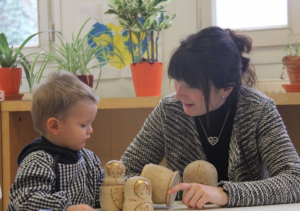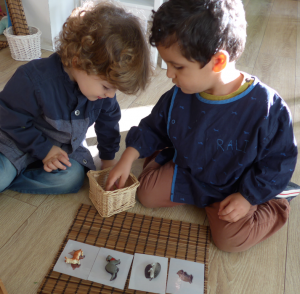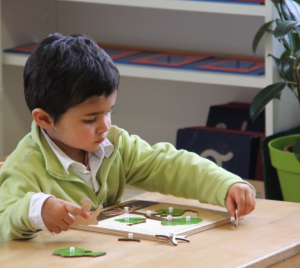Why Montessori
A method fit for the times:
“Let’s not raise our children for today’s world as this world shall no longer exist by the time they are adults. And nothing can tell us what their world will be. So we must teach them to be adaptable.”
Maria Montessori in The Absorbent Mind

As digital technologies have recently drastically changed the way we work, learn, and even live, this quote is a testimony to the relevance of Maria Montessori’s thinking.
The Montessori approach offers personalised teaching, adapted to the pace of each pupil, without any notion of behind ahead or falling behind. It takes into account the fact that each child goes through “sensitive periods”, that is to say moments during which he or she is especially attracted by some aspects of his or her environment which are necessary at the time for his or her development.
The most important aspect of the Montessori approach is the state of mind and the way we look at the child, lovingly and respectfully. A new report is instigated between the adult and the child, one is a guide, the other is in charge of his or her own learning and development. This is summarised by the famous sentence: “Help me to do things by myself”.
The real goal is for the child to be autonomous, independent, responsible and confident. To achieve this, the child must feel unconditionally loved, trusted and trusting, respected and supported. To achieve this, the child must be seen as a being full of potential, energy, self-education, creativity, social skills, and adaptable.
Educating a child is not only about passing on knowledge, it is also about cultivating his or her curiosity, desire to explore, discover, and learn.
How the Montessori method came into being?

Maria Montessori was one of the first female doctor in Europe, she was born in Italy in 1870. She also studied psychology and philosophy.
While working in psychiatric units in Rome, she looked after deficient children and noticed they did not have access to any toys, but she was convinced they needed them to progress, just like anyone needs to use their hands to develop their intelligence. She used the research of two French doctors on deaf-mute people: Edouard Séguin et Jean Itard. She adapted the teaching material they haddevised for the deficient children she was looking after and discovered their needs were more educational than purely medical.
She then founded an orthophrenia school where she observed considerable progress in deficient children. This gave her the idea to use the material she was using with these children with children without any disabilities. In 1907, she looked after children without disabilities of preschool age living in poor districts of Rome. With them she discovered and developed for them her teaching method. She qualified this method as scientific since it was based on observations and experimentation. She called this new school La Casa dei Bambini (the children’s house).
In the following year, several Casa dei Bambini schools opened in Italy, and Maria Montessori trained the teachers. She organised international training programmes welcoming teachers of up to 40 different nationalities. Maria Montessori personally trained 5,000 educators. Many more schools are opened throughout the world, and Maria herself has to travel to flee wars and dictatures. She has lived in the United States, in Spain, in India, and in the Netherlands.
During the 1920’s, she took part in seminars organised by the Ligue Internationale pour l’Education Nouvelle (International League for New Education), where she presented her research and met the other great education thinkers of the time.
In 1929, she founded Association Montessori Internationale (AMI) to preserve, propagate, and promote the teaching principles and practices she had developed for the harmonious development of human beings.
She was nominated several times for a Nobel Prize for her book Education to Peace.
Her son Mario Montessori continued her work until he passed away in 1982.
Today, there are over 30,000 Montessori schools all over the world.
The principles of the Montessori teaching method
The Montessori educational method is based on several principles:
• The freedom to select activities, their duration, and their location (on a table or a rug on the floor), and if they are to be done alone or with other children.
This promotes the respect of the pace and interests of everyone. This develops the ability to work autonomously. The aim is for the child to be satisfied with his or her own learning and to grow according to his or her own development plan. This also promotes a better concentration. because the educator respects the work of everyone, the children learn to respect the work of others.
• Respect for everyone’s own pace, individual activities and experiential learning
Because each child learns better when it’s the right time for him or her, by handling equipment and repeating activities that allow him or her to live a concrete experiment of the concepts apprehended through the equipment.
• Self-discipline
It is considered that when the child is placed in an environment that is propitious because carefully prepared, and rich in opportunities for constructive activities, the child learns alone by handling scientifically developed educational equipment. This develops the child’s ability to motivate and evaluate himself or herself. It is essential to incite the child to correct his or her own mistakes and see them as steps towards success.
To learn more about these principles, we invite you to read Maria Montessori’s books as well as Charlotte Poussin’s book “Apprends-moi à faire seul : la pédagogie Montessori expliquée aux parents” (Eyrolles 2011 – Only available in French) which clearly and simply explains the fundamentals of the Montessori approach.
The fundamentals
The absorbent mind and the sensitive periods
Children absorb what they find in their environment; they possess within themselves unsuspected faculties and abilities. They are natural explorers who can learn spontaneously from their environment. Their thirst for knowledge cannot be quenched!
One of the most important discoveries of Maria Montessori is that of children’s sensitive periods. These are specific and temporary sensitivities that exist in being in construction. They are fleeting and limited to specific acquisitions such as language, order, movements coordination, and the refinement of senses.
Once the period finished, the sensitivity decreases then stops. The opportunity for a natural conquest is lost. During these periods, the child learns with enthusiasm, even passion. The child’s progresses are then so quick it can be amazing. It is therefore essential to identify sensitive periods. When a child is going through one of these periods, it is as if a light was shining on only some things and leaving others in the dark. This is why Montessori promotes the free choice of the activities. The children select their activities depending on the sensitive periods they are going through. In a Montessori atmosphere, each child can pick an activity according to his or her own motivation. Since all children don’t have the same needs at the same time, the Montessori equipment is available at all times, and the child can select a piece of equipment and use it as much as desired to fulfil his or her interest.
The child’s development stages are taken into account to adapt the environment to the needs of the child.
The child is naturally eager to learn and grow. Offering the child a setting where he or she can quench that thirst at the right time and develop his or her intelligence is essential. In a Montessori School, the environment is specially designed according to the physical and psychological needs of children according to their age group:
Taking into account the peculiarities of each age is decisive for promoting the awareness and oneself and of others, as well as the harmonious construction of the personality.
First development stage:
Nido: 0 to 18 months and "Communauté Enfantine": 18 months to 3 years old - "Teach me to be myself"
Second development stage:
Elementary school: 6 to 12 years old - "Teach me to think for myself"
Third development stage:
Erdkinder: 12 to 15 years old - "Teach me to live with others"
The principles of the Montessori classroom

1/ A prepared environment
The environment is tidy and adapted to the size, strength, and needs of the children. It meets their needs while respecting the stages of their development. This environment takes the “sensitive periods” into account (see the section on fundamentals). The class contains: the Montessori equipment made available to children, furniture at the right size for the age of the children and easy to move, art works, plants, animals, and a lot of space so that children can easily move and work on the rugs on the floor if they want to.

2/ Teaching equipment
The equipment is elaborated scientifically, sensory, isolating the difficulties to better apprehend them and allowing self-correction. Another important element: there is only one piece of each equipment in the classroom as this encourages the children to collaborate, share, wait their turn … The child chooses, as far as possible, his or her activity freely. Some support may be necessary. The child handles the equipment after it had been presented by an educator. If needed by the child, the equipment can be presented several times. The child can also learn by observing his or her peers, or the presentation done for another child. When the child handles the equipment, he or she can take his or her time, think, and observe.
The equipment is not a teaching support used by the educator for an academic presentation. It is intended to focus the child’s attention by responding to an inner need related to his or her development. Once interest has been piqued, the child can handle the equipment whenever he or she wants. Handling the equipment allows the child the focus his or her attention and often leads him or her to repeat the activity. This repetition leads to concentration that in turn makes it possible for the child to work on internal structuring. To the choice of a piece of equipment responding to an inner need, will succeed the deliberate choice of a piece of equipment after having thought about it, compared, and willingly selected it. To make this possible, the educators make sure that the child’s activity can take place over a long enough time without interrupting his or her work.

3/ The attitude of the educator
Observant, benevolent, patient, and available. The educator also ensures the class atmosphere fosters concentration. Often, there are two educators in each class, or one educator and one assistant, so that calm can be maintained and ensure the well-being of everyone. The educator presents the equipment as if offering a gift, with great care. It’s like a private lesson that delivers a secret message. The presentation of the equipment is fundamental because it transmits a treasure, it gives a key. The child then explores the equipment in his or her own way, discovers and learns. The educator helps the child to keep a trace of what has been learnt.
A Montessori class, it is also:
• The mixing of ages, within each of the “cycles” This mixture is important because it generates emulation, collaboration and mutual aid. This stimulates the younger children and consolidates the knowledge of the older children. It also develops social skills and a sense of responsibilities. The class is therefore like a small community.
• Work times long enough to allow the development of the concentration. This is why recreational breaks are at the end of a handling phase of at least two hours. Each child finds his or her concentration at his or her own pace and follows his or her own concentration cycle.
• Lessons in 3 steps, or how to assimilate names in three stages. (extract from Apprends-moi à faire seul : la pédagogie Montessori expliquée aux parents, Eyrolles 2011, by Charlotte Poussin)
All concepts are introduced by the lesson in 3 steps, once the child has encountered the concept in practice. This lesson plays a role in the acquisition of language. It allows to name and conceptualise the perceptions. It helps the child to take ownership of the cultural code that is the language, to which he or she surrenders gradually, in 3 steps:
Example of a lesson in 3 steps on colours:
- Name the concept – We put a name on a concept, the word is
“Blue! It’s blue!” The child repeats: “Blue!”; “Yellow! It’s yellow!” The child repeats; “Red! It’s red!” The child repeats.
We make sure we are naming the concept and not the item. We don’t day “The blue plate”, but “blue”. - Ask the child to recognise the concept – The child accepts the word and demonstrates understanding “Can you show me blue?” The child points. If the child makes a mistake, we keep going to allow him or her to correct the mistake by himself or herself.
- Ask the child to use what he or she has acquired – The child takes ownership of the word by using it “What is it? The child replies, “It’s blue.”
The various cycles

The nursery school, called “Communauté Enfantine” is for children as young as 2.
This is the ideal bridge between life at home and school: A familiar environment where each child opens up and progresses at his or her own pace.
- Each child is welcomed individually and has his or her own leaving routine in order to feel at home at school.
- The rest time and the habits of each child are respected.
- Language, practical, and sensory discovery activities are given priority and presented individually.
- Each child is given the opportunity to be autonomous.
The preschool, called “Maison des Enfants” is for children aged 3 to 6 years old.
It consists of 4 areas, each one is allocated to a fundamental subject and contains specific equipment that is presented to each child individually:
• practical life: taking care of the environment and the person
Practical activities to develop the person, his or her concentration, and the rational organisation of his or her thoughts. The practical life equipment is used to allow children to assimilate cultural codes and improve their fine motor skills.

• sensory life: activities developing the children’s sensory refinement
Maria Montessori said that “there is nothing in the intellect that has not gone through the senses”. This equipment invites the children to classify, rank, sort, pair and build gradations, which allows them to have concrete experiences and move towards their conceptualisation by acquiring the appropriate vocabulary.
• language
This equipment allows children to express their thought properly, to work on writing and reading in a sensory and structured manner. The classroom also has a space allocated to music, arts, science, and geography equipment, which are all forms of language.
• mathematics
With this sensory equipment, the child experiments mathematical concepts and develops his or her analysis abilities. The children discover numbers, the decimal system, large mathematical operations, geometrical shapes, and their representation.

The elementary class if for children aged 6 to 12 (CP to CM2 in France, or P1 to P6 in the UK)

At this stage of his or her development, the child is asking: “Help me to think for myself”.
The child has new abilities, he or she is able to apprehend abstract concepts, reason, and imagine. The child is starting to affirm his or her intellectual independence. The child is a cultural explorer.
In addition to the 4 main subjects of Montessori preschool, 4 great themes are introduced. In parallel the children are introduced to the men and women who have left their mark on the development of humanity. This answers the children’s need to identify with extraordinary people.
The children are also taught to organise themselves to work in groups so that they can all find their place and respect the place of other children. We are also talking about the idea of justice, because the child’s ability to judge is under construction.
Maria Montessori invites us to see the universe as a great “intelligent, coherent, organised and alive” organism in which the human being is an actor of the evolution of life, endowed by the nature of intelligence and individual consciousness. The education of children from 6 to 12 years old is done around 5 major lessons presenting a global and coherent vision of the universe, the civilisations, the discoveries and the inventions of humankind to the children:
• the creation of the universe and of our planet, the interdependency and collaboration of the various players, the natural laws, the physical and chemical properties of materials, geography, astronomy, geology, etc.
• the evolution of life on Earth, from the cell to the organ, as an introduction to botanic, zoology, and the concept of space-time.
• the apparition of mankind on Earth and its evolution until us, the fundamental physical and spiritual needs of men, their characteristics and talents, history and biology, etc.
• the invention and evolution of communication systems and symbols (languages, writings, arts, etc.) used by mankind through the study of different human civilizations, etc.
• the evolution of the scientific mind of the human evidenced by the history of numbers and the history of mathematics.

These great lessons are presented to children as stories, fables, illustrated with concrete experiments (the different states of matter and their transformations for example, etc.). Frescoes and symbolic images are used to feed the children’s imagination.
We also take into account the curriculum of the French Education Nationale as published by the French authorities.
